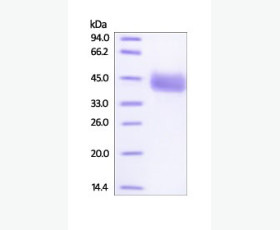Recombinant Human Butyrophilin 1A1/BTN1A1
| Product name: | Recombinant Human Butyrophilin 1A1/BTN1A1 |
| Source: | Human Cells |
| Purity: | Greater than 95% as determined by reducing SDS-PAGE. |
| Buffer Formulation: | Lyophilized from a 0.2 μm filtered solution of 20mM PB, 150mM NaCl, pH 7.2. |
| Applications: | Applications:SDS-PAGE; WB; ELISA; IP. |
| Storage: | Avoid repeated freeze/thaw cycles. Store at 2-8 oC for one month. Aliquot and store at -80 oC for 12 months. |
| UOM: | 100ug/50ug/200ug/1mg/1g |
| Source | Human Cells |
| Description | Recombinant Human Butyrophilin 1A1 is produced by our Mammalian expression system and the target gene encoding Ala27-Arg242 is expressed with a 6His tag at the C-terminus. |
| Names | Butyrophilin Subfamily 1 Member A1, BT, BTN1A1, BTN |
| Accession # | Q13410 |
| Formulation | Lyophilized from a 0.2 μm filtered solution of 20mM PB, 150mM NaCl, pH 7.2. |
| Shipping |
The product is shipped at ambient temperature. |
| Reconstitution |
Always centrifuge tubes before opening. Do not mix by vortex or pipetting. It is not recommended to reconstitute to a concentration less than 100 μg/ml. Dissolve the lyophilized protein in ddH2O. Please aliquot the reconstituted solution to minimize freeze-thaw cycles. |
| Storage |
Lyophilized protein should be stored at < -20°C, though stable at room temperature for 3 weeks. Reconstituted protein solution can be stored at 4-7°C for 2-7 days. Aliquots of reconstituted samples are stable at < -20°C for 3 months. |
| Purity |
Greater than 95% as determined by reducing SDS-PAGE. |
| Endotoxin | Less than 0.1 ng/µg (1 IEU/µg) as determined by LAL test. |
| Amino Acid Sequence |
APFDVIGPPEPILAVVGEDAELPCRLSPNASAEHLELRWFRKKVSPAVLVHRDGREQEAEQMPEY RGRATLVQDGIAKGRVALRIRGVRVSDDGEYTCFFREDGSYEEALVHLKVAALGSDPHISMQVQE NGEICLECTSVGWYPEPQVQWRTSKGEKFPSTSESRNPDEEGLFTVAASVIIRDTSAKNVSCYIQ NLLLGQEKKVEISIPASSLPRVDHHHHHH
|
| Background | Butyrophilin Subfamily 1 Member A1 (BTN1A1) is the major protein associated with fat droplets in the milk. It belongs the immunoglobulin superfamily. BTN1A1 acts as a specific membrane-associated receptor for the association of cytoplasmic droplets with the apical plasma membrane. It is localized to the major histocompatibility complex (MHC) class I region of 6p. It may have arisen relatively recently in evolution by the shuffling of exons between 2 ancestral gene families. It is shown that BTN1A1 inhibits the proliferation of CD4 and CD8 T-cells activated by anti-CD3 antibodies, T-cell metabolism and IL2 and IFNG secretion. |














